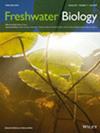Properties of Biofilm Prokaryotic and Eukaryotic Communities in a Representative Hypereutrophic Urban River
IF 2.8
2区 生物学
Q2 ECOLOGY
引用次数: 0
Abstract
- Biofilms play an important role in nutrient and food web dynamics of shallow aquatic ecosystems. Multiple prokaryotic and eukaryotic microorganisms within biofilms interact with each other to shape the community structure and their functional attributes. However, there is no clear understanding of varied patterns of biofilm prokaryotic versus eukaryotic microbial abundances, diversities and communities, which limit our understanding of how biofilm communities and functions in hypereutrophic urban river ecosystems are changing.
- To elucidate the properties of biofilm communities and controls on biofilm communities in a hypereutrophic urban river, we conducted a one-year study to investigate the seasonal and water-depth variations on the abundance/biomass, diversity and structure of biofilm prokaryotic and eukaryotic communities. The structure and dynamics of biofilm prokaryotic and eukaryotic communities were determined by high-throughput sequencing based on the 16S and 18S rRNA gene.
- Sequencing revealed that Proteobacteria, Bacteroidota and Cyanobacteria were the three dominant phyla in biofilm prokaryotic communities, and Rotifera, Chlorophyta, Annelida and Bacillariophyta were the four dominant phyla in biofilm eukaryotic communities. Biofilm bacterial abundance depended mainly on the water temperature, whereas biofilm algal biomass correlated with rotifer grazing and light levels. Prokaryotic communities had higher species richness and diversity than eukaryotic communities. Species richness and diversity displayed significant seasonal variations with minima for prokaryotic communities in winter and eukaryotic communities in summer, which were linked to water temperature and rotifer grazing, respectively. Variations in biofilm prokaryotic and eukaryotic community composition were mainly related to ammonia concentration and water temperature, respectively. The co-occurrence network analysis suggested that rotifer grazing could considerably decrease the complexity of the biofilm network in summer, and the algal groups, especially for Chlorophyta and Bacillariophyta, were the key to the formation of stable biofilm networks.
- There were significant differences in seasonal and water-depth heterogeneity of biofilm prokaryotic and eukaryotic community composition. Our findings indicate that variations in water temperature, light level, rotifer grazing and nutrients (especially ammonia) appreciably contribute to changes in the abundance, diversity and composition of biofilm prokaryotic versus eukaryotic communities in the hypereutrophic urban river.
- These findings increase our understanding of biofilm community characteristics in hypereutrophic urban rivers and provide insights for water pollution remediation strategies.
典型富营养化城市河流生物膜原核和真核群落特性
生物膜在浅水生态系统的营养和食物网动态中起着重要作用。生物膜内的多种原核和真核微生物相互作用,形成群落结构和功能属性。然而,生物膜原核与真核微生物丰度、多样性和群落的变化模式尚不清楚,这限制了我们对富营养化城市河流生态系统中生物膜群落和功能变化的理解。为了阐明城市河流中生物膜群落的特性及其控制措施,本文对城市河流中生物膜原核和真核群落的丰度、生物量、多样性和结构的季节变化和水深变化进行了研究。基于16S和18S rRNA基因的高通量测序测定了生物膜原核和真核生物群落的结构和动态。测序结果显示,变形菌门、拟杆菌门和蓝藻门是生物膜原核生物群落的3个优势门,轮虫门、绿藻门、环节门和硅藻门是生物膜真核生物群落的4个优势门。生物被膜细菌丰度主要取决于水温,而生物被膜藻类生物量与轮虫放牧和光照水平相关。原核生物群落的物种丰富度和多样性高于真核生物群落。物种丰富度和多样性表现出显著的季节变化,冬季原核群落最小,夏季真核群落最小,分别与水温和轮虫放牧有关。生物膜原核和真核生物群落组成的变化主要与氨浓度和水温有关。共生网络分析表明,轮虫放牧可以显著降低夏季生物膜网络的复杂性,藻类类群,尤其是绿藻和硅藻,是形成稳定生物膜网络的关键。生物膜原核生物和真核生物群落组成在季节和水深异质性上存在显著差异。研究结果表明,水温、光照水平、轮虫放牧和营养物(特别是氨)的变化对城市富营养化河流生物膜原核与真核群落的丰度、多样性和组成有显著影响。这些发现增加了我们对富营养化城市河流生物膜群落特征的理解,并为水污染修复策略提供了见解。
本文章由计算机程序翻译,如有差异,请以英文原文为准。
求助全文
约1分钟内获得全文
求助全文
来源期刊

Freshwater Biology
生物-海洋与淡水生物学
CiteScore
5.90
自引率
3.70%
发文量
162
审稿时长
2 months
期刊介绍:
Freshwater Biology publishes papers on all aspects of the ecology of inland waters, including rivers and lakes, ground waters, flood plains and other freshwater wetlands. We include studies of micro-organisms, algae, macrophytes, invertebrates, fish and other vertebrates, as well as those concerning whole systems and related physical and chemical aspects of the environment, provided that they have clear biological relevance.
Studies may focus at any level in the ecological hierarchy from physiological ecology and animal behaviour, through population dynamics and evolutionary genetics, to community interactions, biogeography and ecosystem functioning. They may also be at any scale: from microhabitat to landscape, and continental to global. Preference is given to research, whether meta-analytical, experimental, theoretical or descriptive, highlighting causal (ecological) mechanisms from which clearly stated hypotheses are derived. Manuscripts with an experimental or conceptual flavour are particularly welcome, as are those or which integrate laboratory and field work, and studies from less well researched areas of the world. Priority is given to submissions that are likely to interest a wide range of readers.
We encourage submission of papers well grounded in ecological theory that deal with issues related to the conservation and management of inland waters. Papers interpreting fundamental research in a way that makes clear its applied, strategic or socio-economic relevance are also welcome.
Review articles (FRESHWATER BIOLOGY REVIEWS) and discussion papers (OPINION) are also invited: these enable authors to publish high-quality material outside the constraints of standard research papers.
 求助内容:
求助内容: 应助结果提醒方式:
应助结果提醒方式:


